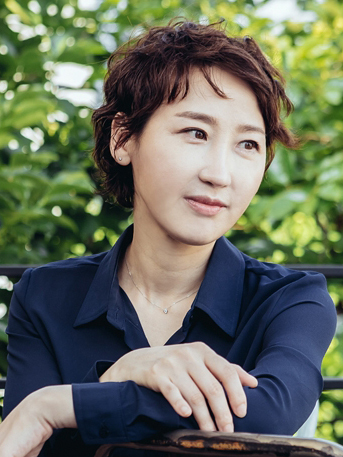Ryu Seong-hee, born in 1968, started out as a ceramic artist. Interested in the impression of movement and the use of space as a form of storytelling, she created many artworks that were specifically designed to work as a dialog with the space they would be exhibited in. Eventually feeling somewhat limited by this artistic form, though, and found inspiration again in an artistic domain that’s all about storytelling and moving images: cinema. After graduating from the Ameri...
More
Ryu Seong-hee, born in 1968, started out as a ceramic artist. Interested in the impression of movement and the use of space as a form of storytelling, she created many artworks that were specifically designed to work as a dialog with the space they would be exhibited in. Eventually feeling somewhat limited by this artistic form, though, and found inspiration again in an artistic domain that’s all about storytelling and moving images: cinema. After graduating from the American Film Institute in production design, she honed her skills making several indie films with friends, with no intent to move back to Korea. One day, upon watching short movies from Song Il-gon, a Korean who studied abroad before starting a career at home, she realized that she too might find interesting opportunities in Korea. Soon after she came back, she got in touch with Son through an acquaintance, and before she knew it, she was given the role of production designer on the director’s debut feature <Flower Island> (2001). In order to gain experience working on more conventional fare, which usually means more restrictive guidelines, she joined the production of <No Blood No Tears> (2001), a mainstream action-drama helmed by Ryoo Seung-wan. The director was so impressed by her work that he recommended her to his close friend, Bong Joon-ho, who was at the time looking for a production designer who could accurately reconstruct the peculiar atmosphere of the 1980s for his new project, <Memories Of Murder> (2003). Having also heard of her from Ryoo, Park Chan-wook decided to attach her to what would become a cult classic celebrated worldwide for his striking visual style, <Old Boy> (2003). Given her achievements with these two thrillers, it might come as no surprise that she was also chosen by Kim Jee-woon for critically acclaimed noir film <A Bittersweet Life> (2004) as well. She would work again with Bong and Park for most of their following films. With the baroque set design in Park’s <Thirst> (2008), she proved once again that she is resourceful enough to find the right tone for each project. After years of being nominated for art direction awards, she finally received her first accolades in 2011 for <The Front Line>, a drama film set on a battlefield during the Korean War. With nothing left to prove, she is now regularly called upon for the production of period pieces. After the early 1980s Busan in <The Attorney> (2013) that recalled dark memories of Korea’s fight against dictatorship, she tackled a monumental undertaking with the epic drama film <Ode to My Father> (2014) which spanned over 50 years of Korean history. She then focused on earlier periods with her two latest films; for Choi Dong-hoon’s smash hit <Assassination> (2015), she had to recreate the cosmopolite neighbourhoods of Shanghai in the 1930s, while in Park Chan-wook’s <The Handmaiden> (2016) she designed the extravagant interiors of the mansion owned by an eccentric lord in a Japanese-occupied Korea. This latter work was unanimously praised and led her to nab international awards such as Best Production Design at the Asian Film Awards and the Vulcan Award of the Technical Artist, one of the highest distinctions in the field. After that, in 2022 she worked on Park’s <Decision to Leave> and Choi’s high-concept fantasy film <Alienoid>, and she also started working for television with the hit series <Little Women>.
Less







